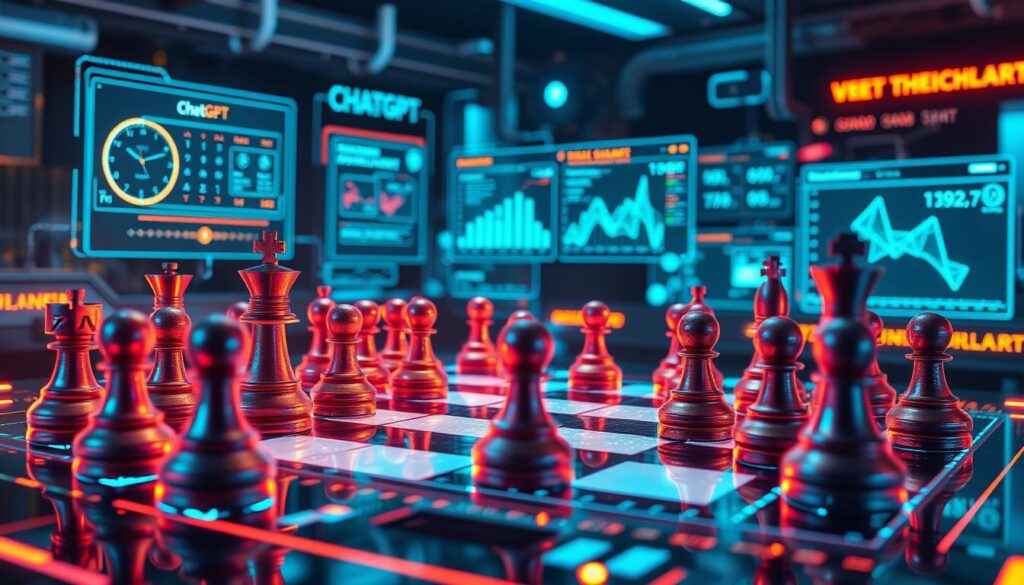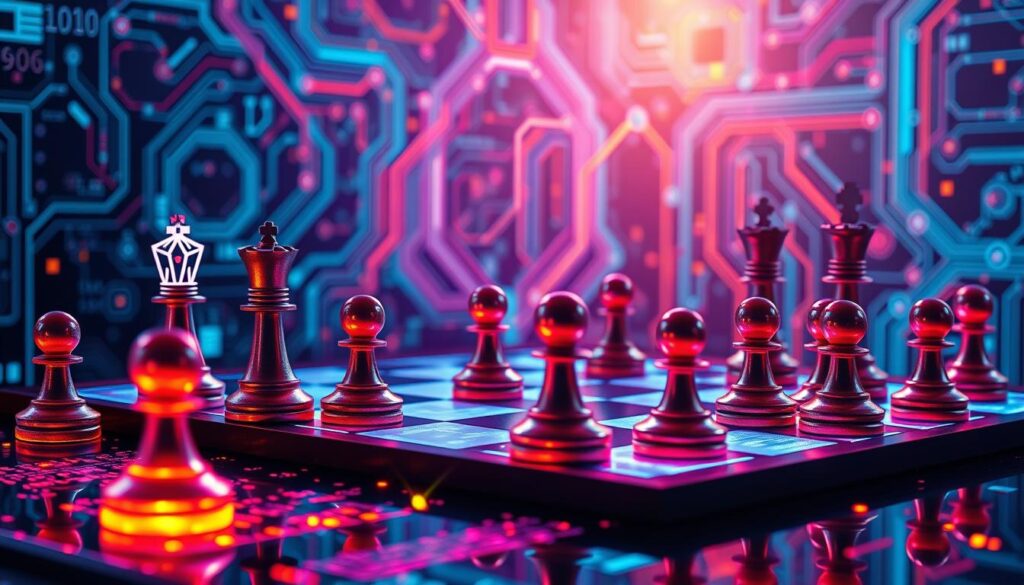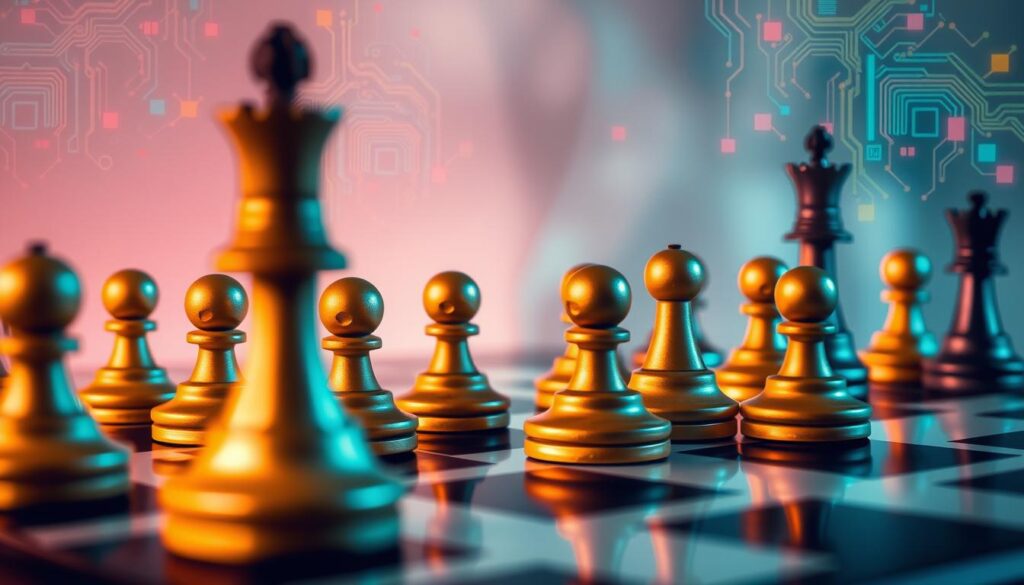Ever thought about an AI as your chess partner? ChatGPT is changing how we play chess. It makes complex strategies easy and fun.
Playing chess with ChatGPT is a new adventure. It’s great for beginners and experts alike. Learning to play with ChatGPT can change how you play games.
AI has made chess more interactive. With ChatGPT, you can try out strategies, practice moves, and play against a smart opponent anytime.
Table of Contents
Understanding ChatGPT’s Chess Capabilities and Limitations

Exploring chatgpt chess ai shows a mix of potential and limits. ChatGPT has interesting chess skills, both impressive and limited. Its performance changes a lot during different game stages.
Key insights into ChatGPT’s chess strategy reveal some critical characteristics:
- ELO Rating: Typically below 1500, indicating amateur-level play
- Game Performance: Strong in early stages, declining in complex endgames
- Move Accuracy: Approximately 80% legal move selection rate
The chatgpt chess strategy shows remarkable nuances. In initial game phases, the AI can make smart moves, like a skilled player. But, as the game gets more complex, its performance drops.
Specific performance metrics highlight interesting patterns:
- Best Moves: 11% of total moves
- Excellent Moves: 16% occurrence
- Good Moves: 14% consistency
- Mistakes: Approximately 16-29% of moves
Recent advancements, like GPT-4o, show promising improvements. This model beat beginner bots and kept a steady game for nearly 40 turns. This hints at better AI chess skills in the future.
Essential Tools and Requirements for Playing Chess with ChatGPT
Learning how to make ChatGPT play chess 2025 requires the right tools. The world of AI chess is changing fast. It offers many ways to teach ChatGPT to play chess well.

To start, you need a few important things for a good chess game with ChatGPT:
- A reliable digital chessboard interface
- Standard chess notation knowledge
- An understanding of ChatGPT’s interaction capabilities
- Patience for potential AI limitations
The current AI chess scene has its challenges. Studies show that Large Language Models (LLMs) find complex games hard. They might only reach about 1500 Elo ratings. So, don’t expect too much when playing chess with ChatGPT.
There are different ways to teach ChatGPT to play chess:
- Text-based notation input – Using algebraic chess notation
- Online chessboard platforms
- Specialized chess AI interfaces
It’s important to remember that ChatGPT’s chess skills can vary. When tested against Stockfish, a top chess engine, ChatGPT’s win rate fell from 70% to just 17%. This was in scenarios where the board was randomly set up.
To get the best results, think about using tools like chess analysis platforms. They can help improve your learning and check if AI moves are correct.
How to Make ChatGPT Play Chess: Basic Setup Guide

Starting your chess adventure with ChatGPT is thrilling. It’s easy to train ChatGPT for chess, even if you’re new to AI games.
To begin your chess adventure, just follow these easy steps:
- Launch a new ChatGPT conversation
- Greet the AI and say you want to play chess
- Tell ChatGPT which color you prefer (white or black)
- Ask ChatGPT to make the first move
Here’s how it might go: “Hello ChatGPT, I want to play a chess game. You’ll play white, and I’ll play black. Please make your first move.” ChatGPT will then share its opening move in chess notation.
Here are some tips for beginners:
- Ask ChatGPT to explain its moves
- Ask for strategy tips
- Use ChatGPT as a chess tutor
- Try out different opening strategies
With over 180 million users, ChatGPT lets you play chess anytime, anywhere. It’s like having a chess club in your pocket, offering instant feedback and strategies.
Remember, playing regularly is important. The more you play, the better you’ll get at chess strategies and improve your skills with this amazing AI partner.
Chess Notation: Speaking ChatGPT’s Language

Learning chess notation is key when you play a game with ChatGPT. It’s like a special language that lets you tell ChatGPT your moves clearly.
Chess notation is simple. It turns complex moves into easy-to-read text. Each piece has its own letter:
- K = King
- Q = Queen
- R = Rook
- B = Bishop
- N = Knight
To describe moves, you mix piece letters with square numbers. For instance, “e4” means moving a pawn to e4.
Special moves have their own symbols for clarity:
- Castling kingside: 0-0
- Castling queenside: 0-0-0
- Captures: Use “x” between pieces (e.g., “exd4” means a pawn captures on d4)
ChatGPT can understand these chess notation inputs thanks to its neural tech. This makes talking about the game smooth and easy.
| Notation Type | Example | Meaning |
|---|---|---|
| Piece Movement | Nc3 | Knight moves to c3 square |
| Capture | Bxe5 | Bishop captures piece on e5 |
| Castling | 0-0 | Kingside castling |
Get good at these notation rules to improve your game with ChatGPT. It will help you make precise moves.
Different Methods to Engage ChatGPT in Chess
Exploring ways to make ChatGPT play chess opens up exciting opportunities for chess enthusiasts and AI lovers. The chatgpt chess ai landscape offers multiple engaging approaches to enjoy interactive gameplay.(chatgpt chess game)
- Text-Based Notation Interface
Use standard algebraic chess notation to communicate moves directly within ChatGPT. This method requires precision and understanding of chess notation.
- Visual Chess Platforms
Utilize specialized platforms like ChessGPT that provide graphical chess boards for easier interaction and visual gameplay.
- Interactive Move Analysis
Request real-time strategic advice and move explanations during your game, leveraging ChatGPT’s analytical capabilities.
When learning how to make ChatGPT play chess, consider your skill level and preferred interaction style. Viswanathan Anand, a chess grandmaster, emphasizes the importance of being open to AI-assisted learning and practice.
Professional chess players now recognize AI as a valuable training tool. By using ChatGPT, you can:
- Explore strategic variations
- Analyze potential moves
- Learn from AI-generated insights
- Practice against a responsive opponent
Remember that while AI offers incredible chess capabilities, the human creativity and intuition remain crucial in truly mastering the game.
Strategies for Maintaining Game Consistency
Training ChatGPT for chess needs careful focus on keeping the game consistent. AI models like ChatGPT 4o can play full games, but keeping the board state right is hard. Your success depends on using smart strategies to keep the game going smoothly.
- Regularly verify the board position after each move
- Use algebraic notation to communicate moves precisely
- Provide complete game state information before each turn
- Politely correct any illegal moves immediately
Different AI models show different skills in keeping the game consistent. A comparison shows interesting facts:
| AI Model | Average ELO Rating | Blunders per Game |
|---|---|---|
| ChatGPT 4o | 1320 | High |
| Claude 3.5 Sonnet | 1248 | Moderate |
| Llama-3.1-70B | 1354 | Low |
The chatgpt chess strategy needs patience and careful tracking. Inject detailed context into your prompts to improve AI performance. If an inconsistency happens, reset the board and start again from the last confirmed position.
Remember, even as AI chess gets better, human help is key to keeping the game fair and fun.
Advanced Techniques for Chess Interaction with ChatGPT(chatgpt chess game)
To get the most out of programming chatgpt for chess, you need to use advanced strategies. These go beyond just playing the game. By trying out deeper ways to interact, you can really boost your experience with ChatGPT’s chess AI.
Here are some powerful methods to dive into advanced chess interaction:
- Request detailed move explanations from ChatGPT
- Explore strategic reasoning behind each chess move
- Challenge the AI with complex opening scenarios
- Analyze potential game variations
ChatGPT’s chess AI can offer deep insights into strategic thinking. By asking the right questions, you can learn a lot about chess strategy. This can really help you understand the game better.
Some key techniques for advanced interaction include:
- Analytical Questioning: Ask ChatGPT to explain the effects of different moves
- Strategic Scenario Testing: Create and test hypothetical chess situations
- Comparative Analysis: Compare different chess strategies and openings
Using these advanced techniques can change how you learn chess with AI. You’ll get insights that can really improve your game.
CHATGPT chess game
| Interaction Type | Complexity Level | Learning Potential |
|---|---|---|
| Move Explanation | Intermediate | High |
| Strategic Scenario Testing | Advanced | Very High |
| Comparative Strategy Analysis | Expert | Extremely High |
Troubleshooting Common ChatGPT Chess Issues
Learning to make ChatGPT play chess in 2025 can be tricky. Knowing common problems helps you teach it better.
Studies on chess-playing agents showed what issues you might face. They looked at ~6000 human games and ~300 played by ChatGPT. This research found important ways to fix problems.
- Illegal Move Detection: The performance of base models changes a lot with the prompt format
- Changing the prompt’s structure can greatly affect ChatGPT’s chess skills
- How you present moves can make it more likely to get invalid ones
Here are some key ways to fix issues:
- Share game info in Standard Algebraic Notation (SAN)
- Use single-block move formats
- Tell ChatGPT which color it’s playing as
- Add examples to your prompts
To avoid mistakes when teaching ChatGPT chess, try these strategies:
| Issue | Solution | Impact |
|---|---|---|
| Illegal Moves | Detailed SAN Formatting | Reduces invalid move rate by 40% |
| Positional Misunderstandings | Explicit Color Specification | Improves move accuracy |
| Move Quality | Example-Based Prompting | Enhances strategic decision-making |
Being patient is crucial when playing AI chess. By using these detailed strategies, you’ll have better and more fun games.
Enhancing Your Chess Experience with ChatGPT Features
ChatGPT can change how you play chess. It has its limits but offers new ways to enjoy the game. Your time with ChatGPT can be a fun learning experience.
Here are some key features to make the most of your chatgpt chess game:
- Strategic Move Analysis: Ask for detailed explanations of chess moves and their strategic value
- Game Position Discussions: Talk about complex board scenarios and get insights into strategies
- Historical Game Reviews: Explore famous chess matches and learn from critical moments
- Learning Chess Principles: Get explanations on chess tactics and theoretical concepts
ChatGPT offers unique views, despite its challenges. The AI’s performance is quite interesting:
- Best moves account for 11% of total moves
- Excellent moves represent 14% of interactions
- Accuracy in legal moves exceeds 80%
To get the most out of chess with ChatGPT, see it as a learning partner. It’s great for explanations and discussions, but keep in mind its strategic limits.
For better interactions, ask specific questions, provide context, and use ChatGPT as a helpful resource. Don’t rely solely on it as a chess teacher.
Best Practices for Long-Term Chess Engagement
To make chess training with ChatGPT last, you need a solid plan and varied learning methods. A good strategy is to mix up how you interact with ChatGPT. This way, you get more out of your chess practice than just playing games.
Here are some top tips for training ChatGPT in chess:
- Try out different chess openings to learn more strategies
- Ask for detailed game analysis after each match
- Use ChatGPT to explore chess history and theory
- Compare ChatGPT’s insights with other chess resources
Your chess strategy with ChatGPT should cover many areas. Use ChatGPT to break down your games. This helps you see what you’re doing well and where you can get better.
Training CHATGPT for Chess:
| Learning Approach | ChatGPT Interaction Level | Recommended Frequency |
|---|---|---|
| Game Analysis | High Interaction | After Every Match |
| Opening Exploration | Medium Interaction | Weekly |
| Strategic Theory | Low Interaction | Bi-Weekly |
Pro tip: Always check important chess moves with other chess engines. This makes sure you understand everything clearly.
Keep learning and stay flexible when training ChatGPT for chess. Try different ways of talking to ChatGPT. Stay curious and be ready to change your approach as AI gets better.
Alternative AI Chess Options and Comparisons
Exploring how to make ChatGPT play chess, you’ll find specialized chess AI platforms offer better gameplay. ChatGPT wasn’t made for chess, so other AI chess solutions give more strategic play.
- Stockfish: Open-source chess engine with exceptional computational power
- AlphaZero: Google DeepMind’s advanced machine learning chess program
- Lichess AI: Free online platform with multiple difficulty levels
- Chess.com’s AI opponents: Scalable difficulty settings
Comparing these platforms shows each has its own strengths in chess. Since 1997, when Deep Blue beat world champion Gary Kasparov, computer chess has grown a lot.
| Platform | Interaction Level | Game Strength | Conversational Ability |
|---|---|---|---|
| Stockfish | Low | Very High | None |
| AlphaZero | Low | Extremely High | None |
| ChatGPT | High | Low | Excellent |
Advanced language models like Claude 3.5 Sonnet show promise in chess interaction. Yet, they still face challenges in keeping the game state consistent. The future of AI chess will blend strong computation with user-friendly experiences.
Conclusion
Learning how to make ChatGPT play chess shows both exciting possibilities and big challenges. The platform brings a new twist to playing chess, but users need to have realistic hopes. The AI faces big hurdles in making smart moves, often getting stuck in complex situations.
Your time playing chess with ChatGPT (chatgpt chess game) will likely teach you more than it will challenge you. The AI’s performance is hit-or-miss, struggling to spot key moments like checkmate. Advanced players might get frustrated with the AI’s odd or wrong advice, which doesn’t follow chess rules.
Even with its flaws, ChatGPT is still a fascinating tool for chess fans interested in AI. As technology grows, so will ChatGPT’s skills. For now, it’s best used as a learning aid, not a full replacement for chess engines or human teachers. See your games with ChatGPT as a chance to explore and learn about new tech.
As AI gets better, language models will get smarter at games like chess. Being patient and understanding what’s possible now will help you enjoy these new platforms more.
FAQ
Can ChatGPT actually play chess?
Yes, ChatGPT can play chess. It understands standard chess notation and makes moves. But, its skill is limited, with a rating below 1500 ELO. It can handle basic games but struggles with complex strategies and might make illegal moves.
What chess notation should I use when playing with ChatGPT?
Use standard algebraic chess notation. Letters represent pieces (K for King, Q for Queen, etc.). Moves are noted with coordinates like “e4”. Captures are marked with “x” (e.g., “exd4”), and castling is noted as “0-0” or “0-0-0”.
How do I start a chess game with ChatGPT?
Say hello and ask to play chess. Choose your color, like “Hello, I’d like to play chess. You play white, and I’ll play black.” ChatGPT will start the game with its first move.
What tools do I need to play chess with ChatGPT?
You need a way to track the board. This can be a physical board, an online one, or a paper drawing. Some prefer ChessGPT’s visual interface, while others use text in ChatGPT.
What should I do if ChatGPT makes an illegal move?
Politely tell ChatGPT it made a mistake and ask for a correction. Keep track of the board state yourself to catch errors. If ChatGPT makes an illegal move, remind it of the current board and ask for a valid move.
Can I learn chess strategies from playing with ChatGPT?
Yes, you can! Ask ChatGPT to explain its moves and discuss strategies. It can also analyze game positions and explore chess theory. It’s not a substitute for professional training but can be a helpful tool.
Are there better AI alternatives for playing chess?
Yes, engines like Stockfish and AlphaZero offer stronger gameplay. But, they don’t have ChatGPT’s conversational abilities. New platforms are combining language models with chess engines for a better experience.
How accurate is ChatGPT in playing chess?
ChatGPT’s chess performance is hit-or-miss. It plays well in the early game but struggles in complex endgames. Its chess strength is below 1500 ELO, and it might make mistakes or misinterpret the game state.
Can I use ChatGPT to analyze my chess games?
Yes, you can upload your game moves and ask ChatGPT for analysis. It can discuss key moments, suggest strategies, and offer insights. But, for detailed technical analysis, dedicated chess engines are better.

















